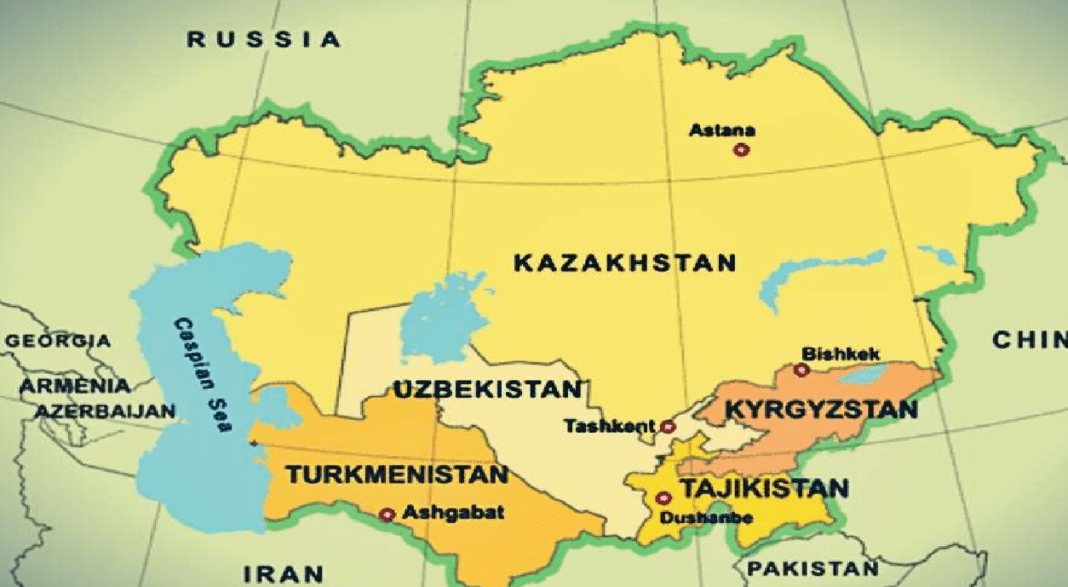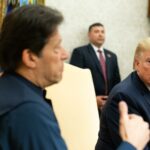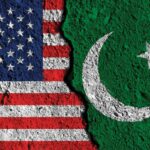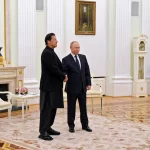The Central Asian Republics have been historically connected to the world through the ancient Silk Road, situated at the crossroads of East Asia, West Asia, South Asia and Europe, their location is excellent for trade. The CARs states are literally a goldmine of energy reserves with Kazakhstan having 30 billion barrels of oil reserves while Turkmenistan’s natural gas is estimated at 265 trillion cubic feet, this wealth makes the region central in the battle for resources between world powers and portend to play an important role in determining global supremacy.
The Central Asian Republics happen to be the nearest and most dependable source of energy supply via fastest trade routes for China’s burgeoning economic growth. Three of the Central Asian states have common borders with the Chinese province of Xinjiang so it is being planned as a future economic and transportation hub for 75% of Chinese trade with CARs. Further down the route Xinjiang connects with Pakistan so it is all set to function as a key trade center on the economic belt. An extensive highway network is to be laid for transporting oil, coal and agricultural products from Xinjiang which would be shipped out from Pakistan’s Gwadar Port. Thus, Central Asia is unlocked once it links to these trade routes and it gains access to the China Pakistan Economic Corridor.
China’s One Belt One Road project kicked off with its first corridor, the China Pakistan Economic Corridor, it would connect the Central Asian Republics (CAR s) to the world with Pakistan becoming a center-point where most routes converge. The CPEC lies at the very heart of an intricate network of corridors working their way through land and sea as they connect vast regions, it can be defined as the most important of the six OBOR corridors and it is the linchpin of the entire strategy.
Additionally, in December 2016, Pakistan became part of the historic Lapis Lazuli corridor which runs through Afghanistan, Turkmenistan, Azerbaijan and Georgia to the Black Sea and Turkey until it leads straight to the Mediterranean Sea and Europe. Two centuries ago, blue lapis lazuli stone was exported from Afghanistan to Europe via the old route, similarly the modern Lapis Lazuli Corridor would encompass a large part of the CAREC Transport Corridor network which connects the Central Asian republics to each other.
Pakistan’s location at the crossroads of West Asia, South Asia, Central Asia and the Middle East makes it the natural gateway for the landlocked Central Asian Republics so it was encouraged to join the Ashgabat Agreement in November 2016. It is an arrangement whereby an international transport and transit corridor is created as a result which facilitates multi-modal transport of goods between Oman, Iran, Turkmenistan, Uzbekistan and Kazakhstan.
Pakistani Foreign Minister Ishaq Dar attended the Pakistan-Afghanistan-Central Asian Republic States Trade Summit (PACTS) in Islamabad in December, 2016, he said “There is a huge trade potential in Afghanistan and five Central Asian states, namely Kazakhstan, Kyrgyzstan, Turkmenistan, Tajikistan and Uzbekistan, with combined gross domestic product (GDP) of $ 445 billion and population of 66 million, offer a sizeable market for Pakistani goods, services and investment.”
Where there are advantages there are drawbacks too and here the negative factor is the presence of various radical Islamist movements that could destabilize the entire region, so it is essential that CARs be integrated and stabilized with trade and economic opportunities to stem militancy before it spreads across the length and breadth of Eurasia. China would like to quell Uighur rebellions in its territory and prevent the influence of militants from the Central Asian countries.
Consequently, the Shanghai Cooperation Organization was formed as a confidence building forum aimed to promote the integration of the region, borders were demilitarized and the vision is to reduce the influence of Western influenced world forums like the United Nations. The focus of the SCO is on economic initiatives, India and Pakistan also became members recently and the mandate has been broadened to include joint security, trade and anti-war pacts.
Central Asia is critically important for Eurasia in its own inimitable manner, as David Denoon writes, ‘Central Asia is important in its own right because it is the vital fulcrum between the dynamism of East Asia and the wealth and technology in Western Europe’.
Pro-actively, Central Asia is being reoriented into the new Silk Road and Eurasian Economic Union to promote the joint objectives and unity of the region.
The U.S. would like to have unrestricted access to the CARs energy reserves and maintains military bases at this valuable strategic location, Russia feels that the U.S. is intruding in its territory and has its own military bases to counter American invasive intentions. The Central Asian states of Kazakhstan, Kyrgyzstan, and Tajikistan are members of the Moscow-led Collective Security Treaty Organization (CSTO) while all the Central Asian Republics are part of the Shanghai Cooperation Organization as well and are well consolidated with China and Russia.
Central Asia is naturally dependent on both Russia and China due to its geography so its inclusion in these forums is to be expected, as Dr. Farkhod Tolipov writes in ‘ONE Belt, One Road and many Countries’,
“Central Asian countries desperately needed to break their newly land-locked status. Forming a trade path from East to West was part of their unique selling point. However, such a position is not merely their geographical destiny. It is also a geopolitical condition due to the fact that unlocking the region depends largely on neighboring great powers – namely China and Russia. But interestingly, the opening and unlocking of Central Asia appears to be a more complicated and protracted process than expected, in which the ‘Modern Silk Road’ needs to balance multiple national interests.”
As an overview, it is important to observe that the common interests of China, Russia and Pakistan have resulted in the emergence of a potential power troika and geopolitical realignment, this new power equation is bonded by economic benefits and the new threat of U.S. /India ties and the developing presence of ISIS in Afghanistan.
Several other countries have similar objectives, for example, Iran benefits from the regional integration and CPEC, especially after its nuclear deal with the U.S. stands scrapped. As for Turkey, it has brotherly relations with Pakistan and wishes to join CPEC too, Central Asian countries are an important market for Turkey and it needs the petroleum they can supply. On the other hand, Afghanistan is deprived from participating actively in all this economic activity, its major setback is the civil war within and the oppressive Indian influence on the present Ashraf Ghani government in Kabul. It could have had tremendous economic benefit from the Central Asian market and South Asian projects and trade corridors.
India would love to have ‘a piece of the cake’ but it chooses to be the last proponent of American supremacy in the region. It would be extremely advantageous for India if it could tap the Central Asian energy resources and lessen its dependence on Iran and the Middle East, the much awaited TAPI (Turkmenistan-Afghan-Pakistan-India) pipeline did not materialize due to the disturbed peace environment in Afghanistan and friction between India and Pakistan. Unfortunately, India objects to CPEC because it’s new best friend U.S. feels threatened if China gets it while the Indians feel it gives Pakistan an unfair advantage, it is a typical case of ‘sour grapes.’ Anyhow, it may still become a part of the wider network OBOR eventually and reap some benefits from the enhanced regional engagement. India also retains a myopic stance on CPEC and OBOR as it suspects the grand ‘String of Pearls’ strategy by China would make its encirclement a reality.
Without any doubt, CPEC is a smart combination of geo-economics and geo-strategy as the economic venture is also a practical extension China’s foreign policy and plans for regional integration.
Ostensibly, CPEC would be a platform for the various regions that comprise Eurasia and the Persian Gulf also becomes accessible for Central Asia via subsidiary corridors. The One Belt One Road project impacts 67 countries and an intricate network of countries benefit from the enhanced connectivity and infrastructure. Many more countries have expressed interest in joining CPEC as soon as China and Pakistan went ahead with it, foreign investment greatly increased as China is known for its sound business decisions. Pakistan is headed in a positive direction, it remains an important stakeholder for stability, peace and development in Afghanistan and CARs and it has helped unite Eurasia with its joint project with China.
As Andrew Korybko writes in his article, ‘Pakistan is the Zipper of Pan-Eurasian Integration’,
“Far from being a lost cause, the country is actually one of the supercontinent’s most important economic hopes, as it has the potential to connect the massive economies of the Eurasian Union, Iran, SAARC, and China, thereby inaugurating the closest thing to an integrated pan-Eurasian economic zone.”
Finally, the strategic significance of all this enhanced connectivity can mean the end of an empire and result in a multi-polar world, shifting the ‘power base’ to Eurasia. US geopolitical strategy has received this setback at a time when it is a progressively weakened force, this is why analysts call this the Eurasian Century, the integration and economic prosperity it offers make its success inevitable.
US Admiral Alfred Thayer Mahan stated in his book ‘The Influence of Sea Power Upon History’ that nations with domination of the seas, such as the British Empire or the USA, would dominate the world.
‘The control of the seas’ is of immense importance for leading the world, and OBOR is a combination of land power and maritime power, it is significant that it extends China’s sea power by linking key Eurasian ports with rails, roads and pipelines in a way never seen before. It opens up the landlocked Chinese hinterland and Central Asian republics and connects them to sea ports, the land area of Eurasia links to enlarged deep-water ports of the OBOR Maritime Silk Road.
The ambitious OBOR project transforms the world’s geopolitical map if successful, there are multiple security threats, regional backlash and rivalry with the ‘status quo’ of world powers which stand to lose their cachet because of it. It would be a master-stroke on the part of China if it can entice the countries which plan to spoil this great game, a mega One Belt One Road Forum is to be held in May this year. There is great possibility that more countries like the U.S. and India would announce their participation or signal their approval of the project by their presence. It promises to be a win-win situation for all if the spoilers become part of OBOR.
References:
https://www.iiss.org/en/publications/survival/sections/2012-23ab/survival–global-politics-and-strategy-june-july-2012-0c11/54-3…
https://www.bloomberg.com/news/articles/2016-11-07/china-s-billions-luring-once-shy-foreign-investors-to-pakistan
http://www.cpecinfo.com/cpec-news-detail?id=ODY4
https://www.thenews.com.pk/print/184799-CPEC-initiative-Xinjiang-to-inject-over-Rs24-bn-on-building-highway-network
https://www.loc.gov/rr/business/asia/CentralAsia/overview.html
http://economictimes.indiatimes.com/news/politics-and-nation/china-wants-india-in-one-belt-one-road-meet-india-remains-wary/articleshow/56383009.cms
http://www.academia.edu/31046533/China_Central_Asia_Relations_and_opportunities_for_Pakistan
https://en.riss.ru/analysis/18882/
http://www.slguardian.org/2016/10/word-the-eurasian-century-is-now-unstoppable/
Sabena Siddiqui, a lawyer and a journalist, writing on geopolitics and International law-related topics. She provides analysis on geopolitics and human rights issues related to the War on Terror, both domestic and international.








